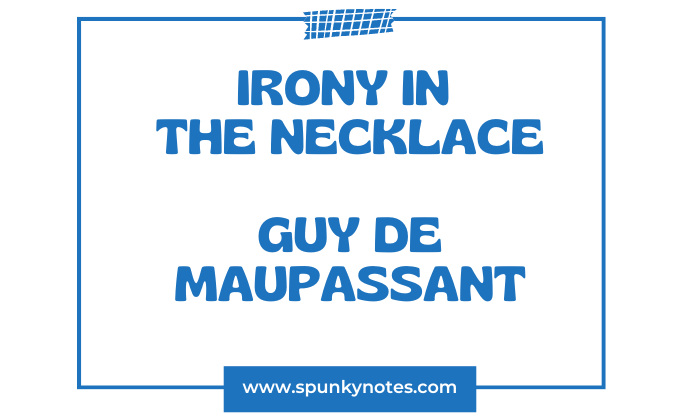
Q. How does Guy de Maupassant use irony in “The Necklace”?
Irony in The Necklace
“The Necklace” by Guy de Maupassant is a story that employs various forms of irony to create a sense of tension and to highlight the superficiality of material possessions.
The irony is a literary device that involves a discrepancy between what is expected and what happens.
In “The Necklace,” Maupassant uses dramatic, verbal, situational, and cosmic irony to enhance the story’s themes and to create a sense of surprise.
Dramatic Irony
In dramatic irony, the reader knows something that the characters in a story do not. In “The Necklace,” the reader knows that the necklace Mathilde borrows and loses is a fake, but Mathilde and her husband do not.
It creates a sense of tension and suspense as the reader wonders when and how they will discover the truth. It also highlights the theme of appearance vs. reality, as Mathilde believes the necklace is real and valuable, while the reader knows it is not.
Mathilde is a character who is obsessed with her appearance and with projecting a certain image onto others. She believes the necklace will bring her the happiness and satisfaction she desires. It will make her look glamorous.
However, the reader knows this is not the case and that the necklace is not worth the trouble Mathilde goes through to borrow and lose it.
The dramatic irony also creates suspense and tension in the story. The reader knows it is futile as Mathilde and her husband struggle to find the lost necklace.
The necklace is not worth the time and money they spend to replace it. The reader also wonders how and when Mathilde and her husband will discover the truth about the necklace and the consequences.
Verbal Irony
Verbal irony is a type of irony that occurs when a speaker says something but means the opposite. In “The Necklace,” several instances of verbal irony exist, particularly in Mathilde’s dialogue with Madame Forestier.
For example, Mathilde remarks on the beauty of the necklace, saying,
“It is stunning…I have never seen anything like it.” Madame Forestier responds with verbal irony, saying, “Oh, yes, you have. You just didn’t notice it.”
It creates a sense of tension and irony, as Mathilde is unaware of the actual value of the necklace.
The dialogue between Mathilde and Madame Forestier is full of verbal irony, as Mathilde praises the beauty of the necklace, and Madame Forestier says that it is only paste. It highlights the superficiality of Mathilde’s desire for wealth and status and emphasizes the contrast between appearance and reality.
Mathilde focuses so much on the appearance of the necklace and what it represents that she becomes blind to the fact that it is not real.
On the other hand, Madame Forestier, who knows the true value of the necklace, understands its true nature. As a result, she doesn’t care much about how it looks.
The verbal irony also creates a sense of tension and surprise in the story. When Madame Forestier reveals that the necklace is fake, the reader is surprised and perhaps even shocked, as this twist of fate was unexpected.
The verbal irony between Mathilde and Madame Forestier sets up this surprise ending and creates a sense of irony and futility in Mathilde’s pursuit of wealth and status.
Situational Irony
Situational irony occurs when a situation’s outcome is the opposite of what was expected. The entire plot of “The Necklace” exemplifies situational irony.
Mathilde desires the necklace and the lifestyle it represents, but her desire for wealth and status leads to her living in poverty for years. The necklace she borrows and loses is a fake, an ironic twist of fate.
Mathilde desires material possessions and a glamorous lifestyle. She believes that a necklace will bring her happiness. Unfortunately, her downfall comes when the necklace turns out to be worthless.
The situational irony in “The Necklace” emphasizes the story’s central themes, particularly the dangers of pride and vanity and the superficiality of material possessions.
Mathilde obsesses over her appearance and projects a certain image onto others. She believes that the necklace will do the work. However, her desire for wealth and status leads to her downfall, as she and her husband spend years in poverty to pay off the debt incurred by losing the necklace.
The situational irony also creates a sense of futility in Mathilde’s pursuit of wealth and status. She spends years working hard to pay off the debts incurred by losing the necklace, only to discover that it is fake.
It creates a sense of irony and futility, as Mathilde’s pursuit of wealth and status led to years of suffering and hardship, only to discover that the object of her desire was not worth the effort.

